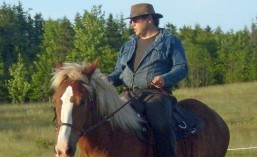Location: Northeast Nova Scotia, Twa Corbies Hollow, approx. 1 hr from New Glasgow and Antigonish
Date & Time: April 25, 26 & 27, beginning 1000 Friday; ending 1400 Sunday.
Cost: $350 per person
Equipment Required: Warm to cold weather outdoors clothing for wet and dry conditions, and waterproof, insulated hiker boots. Also mandatory: knife, sleeping bag, sleeping pad, backpack, compass and waterproof matches. Also bring any other personal outdoor gear and toiletries you require. Recommended: binoculars and camera.
Level: moderate to advanced
Contact: twa.corbies.hollow@gmail.com
Join tracker and wilderness veteran of thirty years, Cliff Seruntine, and learn to speak the language of the land during a three day guided tracking course in the field. Camp in provided tipis or lean-to’s and enjoy some fine outdoor campfire cooking and tales.
Course Description: Animals speak in all kinds of ways, even if they don’t use the spoken word. Their language is honest and straightforward–communicated in what they do, where they go, and what they leave behind.
In this three day and two night course, students will wander the expansive woods and glades around Twa Corbies Hollow and learn to identify the tracks of various wildlife that may include white tail deer, moose, coyotes, black bears, fishers, martens, foxes, squirrels, beavers and more. They will learn how to identify game trails, how to identify tracks, how to interpret droppings and learn where animals have been spending their time, what they’ve been eating and what they’e been doing. They will learn to put the various clues of the land together to determine age of trails and the lifeways of animals. They will learn to cast tracks with plaster and how to shoot useful photographs of tracks and other spoor. And they will learn how to camouflage themselves and take advantage of cover to observe and photograph wildlife.
Students will camp at either of the base camps that are part of the school. Tipis, lean-to’s or other bushcraft shelters will be provided though students are welcomed to bring their own tents if they prefer. Students will require their own backpacks, sleeping bags and sleeping pads. Students should bring their own snacks and lunches, but breakfast and dinner are provided–cooked using traditional outdoors methods. Meals will be such things as stews, flat bread, tea and coffee.
Because this course will require three days in the woods with two nights at camp, and a considerable amount of hiking, participants must be in moderately good health and know they are capable of up to four miles hiking through rough terrain per day. Good outdoor clothing and footwear are mandatory, as is a good bushcraft knife. Weather can vary greatly at this time of year, so be prepared for warm to cold weather, and wet or dry conditions. April is an ideal time for tracking as freshly revealed ground and snow pockets in shadows make for good imprints and hungry animals leaving lots of spoor.
No tracking background or experience is required. However, all students should have a basic understanding woodland hiking and camping skills.




